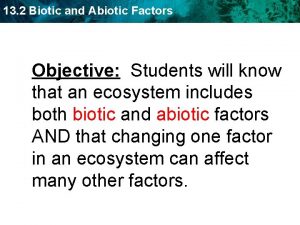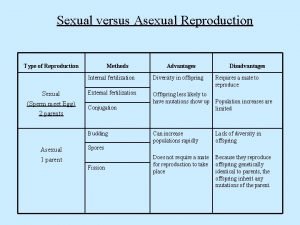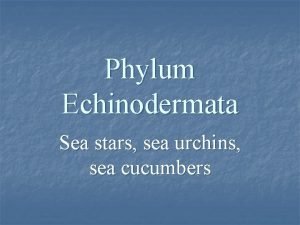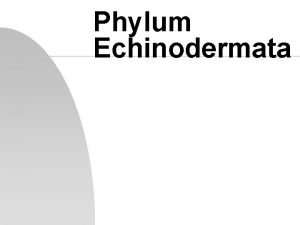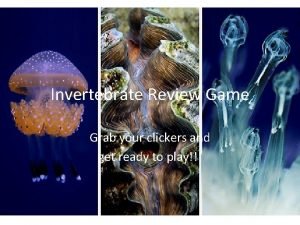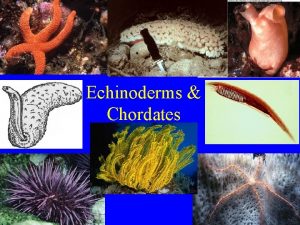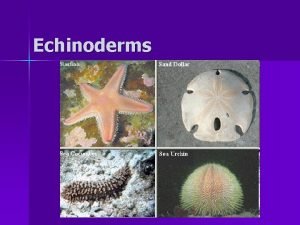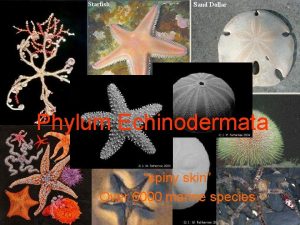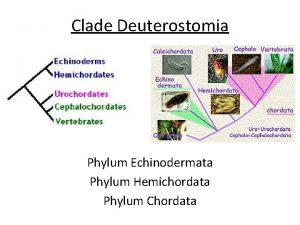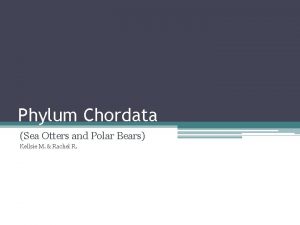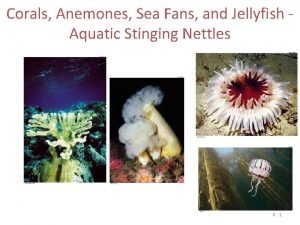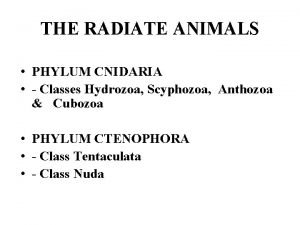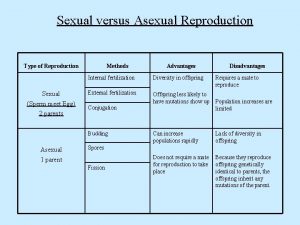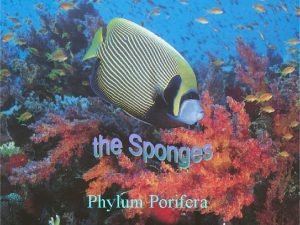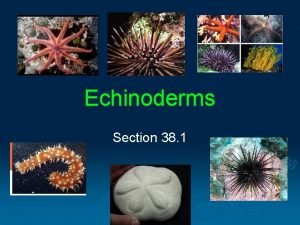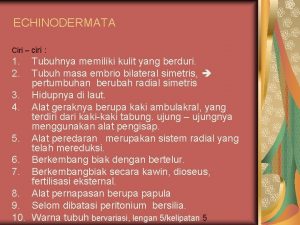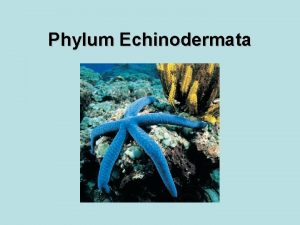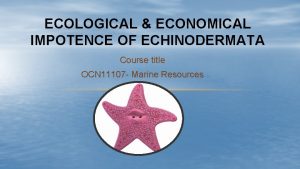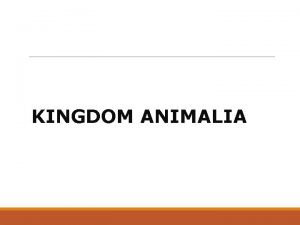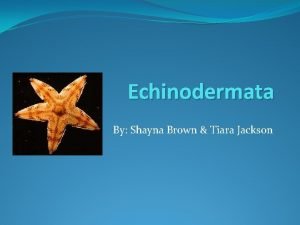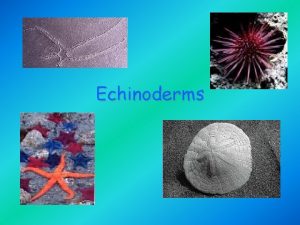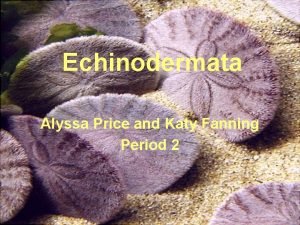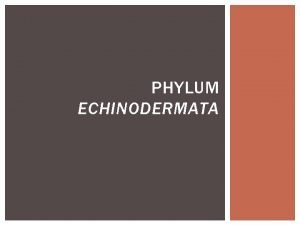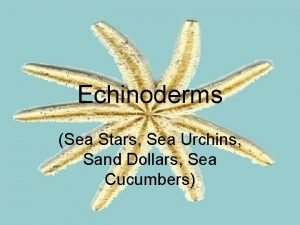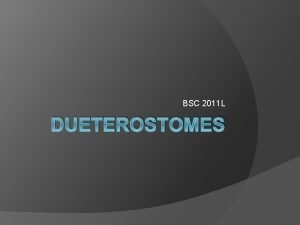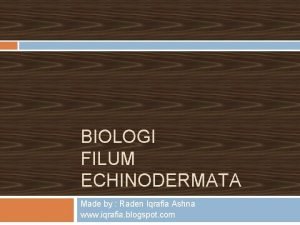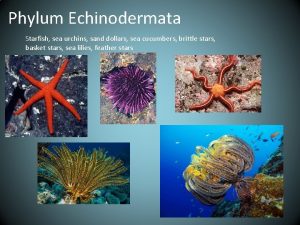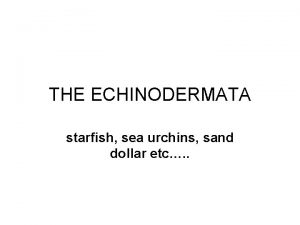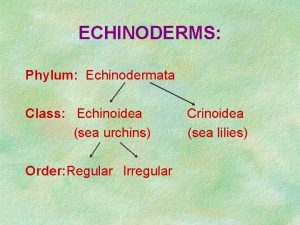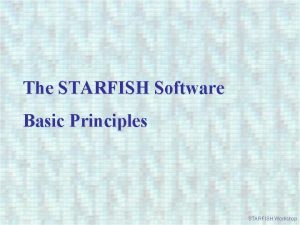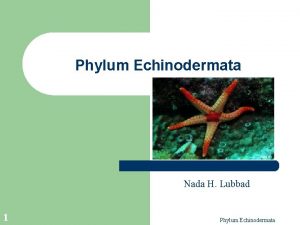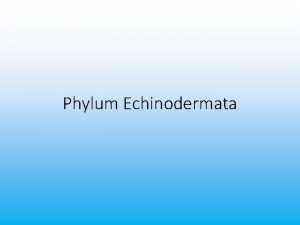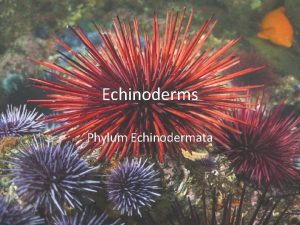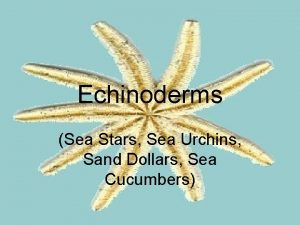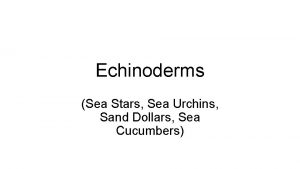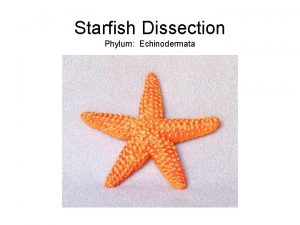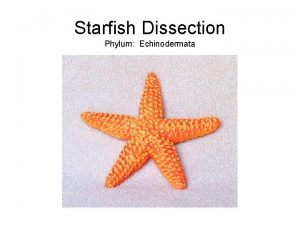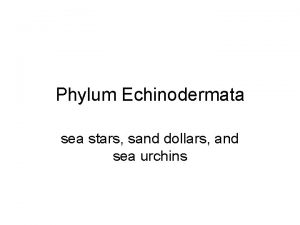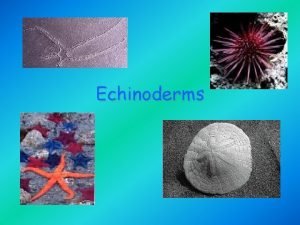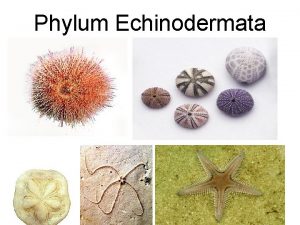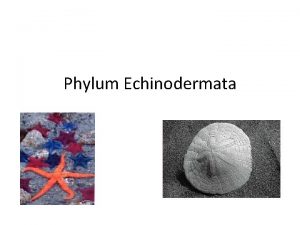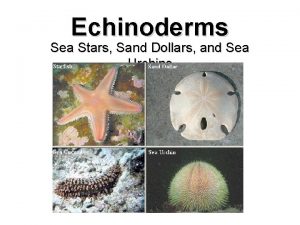Phylum Echinodermata Phylum Echinodermata Includes starfish sea urchins


































- Slides: 34

Phylum Echinodermata

Phylum Echinodermata Includes starfish, sea urchins, sea cucumber & sand dollars l “Spiny-skinned” l Radial Symmetry l

Phylum Echinodermata: Anatomy l Water Vascular System: -- Series of water-filled canals -- Carries out functions including respiratory, circulation, and movement. -- Oxygen, food, & wastes are carried by the water vascular system.

Phylum Echinodermata: Anatomy l Water enters madreporite and flows through the stone l l canal and then enters the circular ring canal. Water then is separated into five radial canals that branch into double rows of bulblike structures called ampullae, which are on each side of the ambulacral ridge. The ampullae are connected to suckerlike podia = tube foot

Water Vascular System

Phylum Echinodermata: Anatomy l l Have 5 sections or rays or arms Tube Feet: -- Act like suction cups -- Extend from the body -- Used to “walk”, capture, and hold prey

Tube Feet

Echinodermata: Anatomy Lack a true centralized brain. l All echinoderms have a network of interlacing nerves called a nerve plexus which lies within as well as below the skin. l They are sensitive to touch, light, temperature, orientation, and the status of water around them. l

Class Asteroidea Star Fish

Starfish: External Anatomy l Typically have 5 arms l Arms emerge from a central disc l Have an endoskeleton of small calcareous plates called ossicles

Starfish: External Anatomy l From the ossicles project spines & tubercles that are responsible for their spiny surface

Starfish: External Anatomy l On the oral surface -- Ambulacral grooves: Radiate out along the arms from the centrally located mouth -- Tube feet project from the grooves Ambulacral Groove

Starfish: External Anatomy l On the oral surface -- A large radial nerve can be seen in the center of each ambulacral groove between the rows of tube feet. -- Under the radial nerve is an extension of the coelom and the radial canal of the water-vascular system

Phylum Echinodermata: Internal Anatomy l They have two stomachs. l One stomach is used for digestion, and the other stomach can be extended outward to engulf and digest prey.


Phylum Echinodermata: Anatomy l Starfish push their stomach out once prey is caught. -- Stomach pushes out of mouth to surround prey (ex: clam) -- Pours out enzymes -- Digests clam in its own shell -- Then it pulls its stomach and the partially digested prey into its mouth.

Groups of Echinoderms l Sea Stars or Starfish -- Preys on bivalves -- Regenerates arms -- If pulled apart into pieces, each piece will grow into a new animal, as long as it contains a portion of the central part of the body.

Groups of Echinoderms: Regeneration l Most species can only regenerate if the central part of the body is intact, but a few species can grow back even from a single ray.

Reproduction l Starfish are capable of both sexual and asexual reproduction. l Individual starfish are male or female. Fertilization takes place externally, both male and female releasing their gametes into the environment. l Resulting fertilized embryos form part of the zooplankton.

Reproduction l The fertilized embryos that float as zooplankton are known as deuterostomes. l The deuterostomes then become a larva that are bilateral symmetrical. l As they grow, they then change to radial symmetrical adults.

Class Echinoidea Sea Urchins & Sand Dollars

Class Echinoidea l Sea Urchin -- Eat algae -- Have calcium carbonate plates covered with spines. -- Can swivel spines -- Many animals prey on sea urchins -- people eat sea urchins

Sea Urchins Sea urchins are one of the sea otters favorite food. l Sea otters keep sea urchin populations in check. Without sea otters, the sea urchins can devastate kelp forests which upsets the ecosystem. l

Sea Urchins l On the oral surface of the sea urchin is a centrally located mouth made up of five united calcium carbonate teeth or jaws, with a fleshy tongue-like structure within. l The entire chewing organ is known as Aristotle's lantern.

Sea Urchins l Shell, which is also called the "test", is globular in shape and covered with spines.

Sea Urchin l The spines, which in some species are long and sharp, serve to protect the urchin from predators and aid in locomotion. l The spines can inflict a painful wound on a human who steps on one, but they are not seriously dangerous, and it is not clear that the spines are truly venomous

Sand Dollars

Class Echinoidea l Sand Dollars -- Flattened disk -- Few animals eat/bother sand dollars. -- Burrows into the sand. -- Also called sea biscuits.

Class Holothuroidea Sea Cucumbers

Class Holothuroidea l Sea Cucumbers: -- Look like warty moving pickles -- Benthic: Live on the ocean floor

Sea Cucumbers Are little bull dozers -- Eat detritus in sand -- Suck up organic matter & remains of other organisms.

Sea Cucumbers -- Sea cucumbers extract oxygen from water in a pair of 'respiratory trees' that branch off the cloaca just inside the anus, so that they 'breathe' by drawing water in through the anus and then expelling it.

Sea Cucumbers l A variety of fish, most commonly pearl fish, have evolved a Mutualistic symbiotic relationship with sea cucumbers in which the pearl fish will live in sea cucumber's cloaca (anus) using it for protection from predation l The pearl fish’s waste provides a source of food/nutrients to the sea cucumber

Class Holothuroidea -- When threatened, they spill their guts! -- It takes 1 ½ to 5 weeks to re-grow their guts -- The predator will eat the ejected guts, & leaves the sea cucumber alone. It eventually grows back the lost organs. people eat them!
 Sea urchin biotic factors
Sea urchin biotic factors Spider phylum
Spider phylum Class concentricycloidea characteristics
Class concentricycloidea characteristics Brittle stars phylum
Brittle stars phylum What phylum does squidward belong to
What phylum does squidward belong to Starfish
Starfish Echinoderm facts
Echinoderm facts Phylum echinodermata
Phylum echinodermata Sea cave
Sea cave What is asias largest desert
What is asias largest desert Jellyfish
Jellyfish Marlin symbolism
Marlin symbolism Troy aegean sea
Troy aegean sea Phylum
Phylum Phylum of polar bear
Phylum of polar bear Mollusca class
Mollusca class 8 phyla of invertebrates
8 phyla of invertebrates Fire corals and siphonophores are in class
Fire corals and siphonophores are in class Anemone life cycle
Anemone life cycle Sea urchin asexual reproduction
Sea urchin asexual reproduction Aplysina
Aplysina Section 38-1 review echinoderms answer key
Section 38-1 review echinoderms answer key Ciri ciri echinodermata
Ciri ciri echinodermata Phylum
Phylum Economic importance of echinoderms
Economic importance of echinoderms Sistema digestivo reptil
Sistema digestivo reptil Filum animalia
Filum animalia Echinoderms characteristics
Echinoderms characteristics Echinoderms body cavity
Echinoderms body cavity Taxonomists have divided echinoderms into classes
Taxonomists have divided echinoderms into classes Germ layers of echinodermata
Germ layers of echinodermata Echinodermata endoskeleton
Echinodermata endoskeleton Sand dollar phylum
Sand dollar phylum Dueterostomes
Dueterostomes Contoh holothuroidea
Contoh holothuroidea
